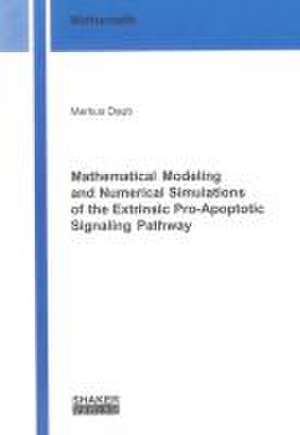Mathematical Modeling and Numerical Simulations of the Extrinsic Pro-Apoptotic Signaling Pathway: BERICHTE AUS DER MATHEMATIK
Autor Markus Dauben Limba Engleză Paperback – 28 feb 2013
Din seria BERICHTE AUS DER MATHEMATIK
-
 Preț: 60.73 lei
Preț: 60.73 lei -
 Preț: 81.85 lei
Preț: 81.85 lei -
 Preț: 205.72 lei
Preț: 205.72 lei -
 Preț: 260.75 lei
Preț: 260.75 lei -
 Preț: 92.46 lei
Preț: 92.46 lei -
 Preț: 279.63 lei
Preț: 279.63 lei -
 Preț: 94.15 lei
Preț: 94.15 lei -
 Preț: 108.71 lei
Preț: 108.71 lei -
 Preț: 283.35 lei
Preț: 283.35 lei -
 Preț: 97.68 lei
Preț: 97.68 lei -
 Preț: 92.37 lei
Preț: 92.37 lei -
 Preț: 96.52 lei
Preț: 96.52 lei -
 Preț: 269.96 lei
Preț: 269.96 lei -
 Preț: 153.29 lei
Preț: 153.29 lei -
 Preț: 294.47 lei
Preț: 294.47 lei -
 Preț: 87.27 lei
Preț: 87.27 lei -
 Preț: 219.43 lei
Preț: 219.43 lei -
 Preț: 289.52 lei
Preț: 289.52 lei -
 Preț: 284.76 lei
Preț: 284.76 lei - 20%
 Preț: 102.96 lei
Preț: 102.96 lei -
 Preț: 92.60 lei
Preț: 92.60 lei -
 Preț: 277.45 lei
Preț: 277.45 lei -
 Preț: 104.23 lei
Preț: 104.23 lei -
 Preț: 80.94 lei
Preț: 80.94 lei -
 Preț: 96.65 lei
Preț: 96.65 lei -
 Preț: 81.85 lei
Preț: 81.85 lei -
 Preț: 64.69 lei
Preț: 64.69 lei -
 Preț: 87.57 lei
Preț: 87.57 lei -
 Preț: 99.79 lei
Preț: 99.79 lei -
 Preț: 249.55 lei
Preț: 249.55 lei -
 Preț: 112.65 lei
Preț: 112.65 lei -
 Preț: 280.93 lei
Preț: 280.93 lei -
 Preț: 289.36 lei
Preț: 289.36 lei -
 Preț: 277.61 lei
Preț: 277.61 lei -
 Preț: 111.41 lei
Preț: 111.41 lei -
 Preț: 217.51 lei
Preț: 217.51 lei -
 Preț: 74.35 lei
Preț: 74.35 lei -
 Preț: 264.73 lei
Preț: 264.73 lei -
 Preț: 111.33 lei
Preț: 111.33 lei -
 Preț: 280.93 lei
Preț: 280.93 lei -
 Preț: 68.48 lei
Preț: 68.48 lei -
 Preț: 299.93 lei
Preț: 299.93 lei -
 Preț: 83.23 lei
Preț: 83.23 lei -
 Preț: 96.27 lei
Preț: 96.27 lei -
 Preț: 89.47 lei
Preț: 89.47 lei -
 Preț: 92.36 lei
Preț: 92.36 lei -
 Preț: 207.88 lei
Preț: 207.88 lei -
 Preț: 90.00 lei
Preț: 90.00 lei -
 Preț: 149.17 lei
Preț: 149.17 lei
Preț: 280.55 lei
Nou
Puncte Express: 421
Preț estimativ în valută:
53.70€ • 56.42$ • 45.13£
53.70€ • 56.42$ • 45.13£
Carte indisponibilă temporar
Doresc să fiu notificat când acest titlu va fi disponibil:
Se trimite...
Preluare comenzi: 021 569.72.76
Specificații
ISBN-13: 9783844017281
ISBN-10: 3844017283
Pagini: 184
Ilustrații: 39 farbige Abbildungen
Dimensiuni: 152 x 211 x 17 mm
Greutate: 0.26 kg
Editura: Shaker Verlag
Seria BERICHTE AUS DER MATHEMATIK
ISBN-10: 3844017283
Pagini: 184
Ilustrații: 39 farbige Abbildungen
Dimensiuni: 152 x 211 x 17 mm
Greutate: 0.26 kg
Editura: Shaker Verlag
Seria BERICHTE AUS DER MATHEMATIK
